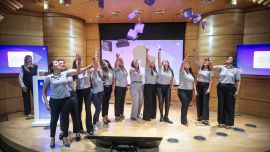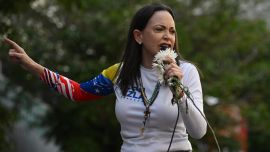Forty years and one day ago, on September 6, 1979, a delegation from the Inter-American Commission on Human Rights (IACHR) arrived in Argentina. That trip, one for history books, would lay the groundwork for a momentous report that would alter the perception of the country’s last military dictatorship (1976-1983) forever.
The officials from IACHR (or CIDH, to use its Spanish acronymn) had a simple, brief and exceptionally difficult mission: to verify allegations of torture, persecution, extrajudicial executions and forced disappearances carried out at the request of the military dictatorship, as part of a systematic campaign of state terrorism.
The delegation would remain in Argentina until September 20, receiving victims and recording denunciations at the offices of the Organisation of American States (OAS) on Avenida de Mayo 700. Over that fortnight they received no less than 5,580 denunciations from the families of victims with a further 3,000 coming from local human rights organisations.
“I arrived in the morning very early and had to queue for several hours to present my case. It was a very long row that turned the block. We were all family members who had been looking for our disappeared for years,” Cristina Muro, the wife of Carlos Alberto Chiappolini, kidnapped by the ESMA taskforces in February, 1977, told Télam this week, remembering her visit.
Commemoration
To commemorate the historic anniversary, a delegation of IACHR officials arrived in town yesterday, touring the Espacio Memoria y Derechos Humanos at the ex-ESMA Navy Mechanics School concentration camp, accompanied by members of local human rights organisations.
The officials visited the El ocultamiento de la ESMA: la verdad se hace pública (“Cover-up at the ESMA: truth will out”) exhibition, organised by the human rights organisations Memoria Abierta, CELS (Centro de Estudios Legales y Sociales), the Grandmothers of Plaza de Mayo, Familiares de Desaparecidos y Detenidos por Razones Políticas (“Families of the Missing and Political Prisoners”) and Espacio Memoria.
“On the basis of new evidence, the exhibition of objects and the presentation of documents, it is now possible to know details from the period in which the ESMA taskforces came up with every kind of strategy to hide all evidence of repressive activity in the face of the imminent arrival of the IACHR,” the organisers said.
The exhibition, which will run until December 10 and will be open to visitors from Tuesday to Sunday between 10am and 5pm, also shows “the methods used by the families, the role of human rights organisations, the transition from individual lawsuits to class action and the denunciations made to the Commission.”
The inauguration of the exhibition was followed by a panel on “The historic impact of the IACHR’s work and the new challenges within the current regional context,” featuring the participation of Grandmothers president Estela Barnes de Carlotto, former IACHR vice-president Víctor Abramovich and Taty Almeida of the Mothers of Plaza de Mayo-Founding Line.
Later, the visitors attended a commemorative ceremony at the Olivos presidential residence headed by President Mauricio Macri, at which a plaque was unveiled.
Among the IACHR officials present were President Esmeralda Arosemena, First Vice-President Joel Hernández, Commissioner Antonia Urrejola, Executive Secretary Paulo Abrão, the latter’s special assistant Erick Mendoca and public relations co-ordinator Constanza Argentieri. Government officials including Justice and Human Rights Minister Germán Garavano and Human Rights Secretary Claudio Avruj were also in attendance, alongside a host of diplomats.
Speaking at the event, President Macri declared that “Truth and Justice continue to endure as state policies.”
“I also want to emphasise that memory is essential, in order to know our history and what we do not want to repeat in our future. It is the best way we have to unite in those republican values we share. By that, I mean dialogue, peace and respect,” he said.
As well as Arosemena, former CONADEP member Graciela Fernández Meijide also spoke praising the report. “Today I can say that it was a turning-point in the history of the struggle for human rights, in the history of the IACHR itself and in the history of our country,” she said.
Disappearances
Presentations before the IACHR concerning human rights violations committed in Argentina dated back to 1975, but after the coup d’état of March 24 the following year, complaints multiplied, especially those referring to cases of disappearances.
The military dictatorship headed by Jorge Rafael Videla initially refused to receive the members of the IACHR, even going to the point of launching a smear campaign against human rights organisations.
However, pressure exerted by the president of the United States, Jimmy Carter, and his secretary of Human Rights, Patricia Derian, led to the dictatorship accepting the visit of an IACHR delegation in late 1978, although the watchdogs only arrived nine months later, giving the regime plenty of time to clean up incriminating evidence at suspected detention centres. There were massive transfers of prisoners in those nine months.
During its visit, the IACHR visited clandestine detention and torture centres such as ESMA itself and La Perla in Córdoba, held meetings with the dictatorship and opened three offices across the country.
The Junta did their best to clear up. Detainees at ESMA were taken to an island in the Paraná Delta known as “El Silencio” (“The Silence”) and the building itself underwent structural changes to try to hide what was happening there.
After collecting thousands of denunciations, the IACHR proceeded to write a highly critical report which was published in April 1980, concluding that the violence and human rights abuses were the result of state terrorism.
The report was a turning-point: it raised awareness of the horrors going on in the country and changed international perceptions of Argentina.




















Comments